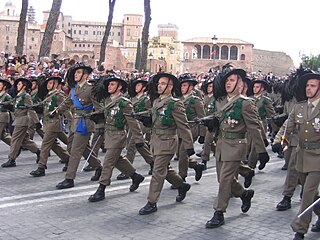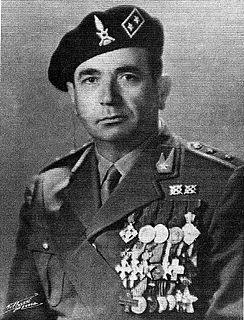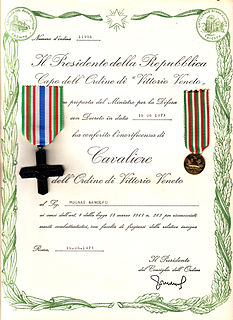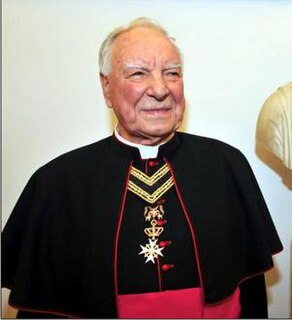
The Sovereign Military Order of Malta (SMOM), officially the Sovereign Military Hospitaller Order of Saint John of Jerusalem, of Rhodes and of Malta, commonly known as the Order of Malta, Malta Order or Knights of Malta, is a Catholic lay religious order, traditionally of a military, chivalric and noble nature. Though it possesses no territory, the order is a sovereign entity of international law and maintains diplomatic relations with many countries.
The Silver Medal of Military Valor is an Italian medal for gallantry.

The Bersaglieri, singular Bersagliere,, "sharpshooter") are a speciality of the Italian Army's infantry corps. They were originally created by General Alessandro La Marmora on 18 June 1836 to serve in the Royal Sardinian Army, which later became the Royal Italian Army. They can be recognized by their distinctive wide-brimmed hats decorated with black capercaillie feathers, which is worn with the dress uniform. The feathers are also applied to their combat helmets.
The Consulta Araldica was a college instituted by royal decree on 10 October 1869 to advise the Italian government on noble titles, coats of arms and related matters. It was a department of the Ministry of the Interior, combining the roles of the various heraldic colleges which had existed in pre-unification Italy, including the Tribunale Araldico of Lombardy, the Commissione Araldica of Venice and the Congregazione Araldica Capitolina of Rome.

The Ministry of Defence is the government body of the Italian Republic responsible for military and civil defence matters and managing the Italian Armed Forces. It is led by the Italian Minister of Defence, a position occupied by Lorenzo Guerini since September 2019.

The history of Rhodes under the Order of Saint John lasted from 1310 until 1522. The island of Rhodes was a sovereign territorial entity of the Knights Hospitaller who settled on the island from Palestine and from Cyprus, where they did not exercise temporal power. The first Grand Master was the French Foulques de Villaret (1305–1319).
Luigi Frusci was an officer in the Italian Royal Army during the Italian conquest of Ethiopia and World War II. He was the last Italian Governor of Eritrea and Amhara (Ethiopia).

Francesco de Martini was an Italian officer of the Military Information Service in Eritrea, when the Allies invaded Italian East Africa during World War II. He enlisted as a private in the Italian army in 1923, and left active service as brigadier general and the most decorated soldier of the Italian army during World War II.

Palazzo Malta, officially named as the Magistral Palace, and also known as Palazzo di Malta or Palazzo dell'Ordine di Malta, is the more important of the two headquarters of the Sovereign Military Order of Malta, a Roman Catholic lay religious order and a sovereign subject of international law. It is located in Via dei Condotti, 68 in Rome, Italy, a few minutes' walk from the Spanish Steps, and has been granted extraterritoriality by the Italian Government. The Palace has been a property of the Order of Malta since 1630.

Fra' Giacomo dalla Torre del Tempio di Sanguinetto was the Prince and 80th Grand Master of the Sovereign Military Order of Malta. Born in Rome to a noble family with extensive ties to the Vatican, he completed his studies at the Sapienza University of Rome and taught at the Pontifical Urban University. He joined the Order in 1985 and took full vows in 1993 to become a Knight of Justice. Dalla Torre served two separate stints as interim leader of the Order, from February to March 2008 and again from 2017 until 2018. He was elected Grand Master of the Order on 2 May 2018 and served until his death. During his time in office, he endeavoured to repair the Order's relations with the Vatican, which had been strained since Pope Francis ordered his predecessor to resign.

The Italian honours system is a means to reward achievements or service to the Italian Republic, formerly the Kingdom of Italy including the Italian Social Republic.

Azelio Giuseppe Maria Manzetti de Fort was an Italian priest who was served as the Chief Chaplain of the Military Corps of the Sovereign Military Order of Malta, as well as Chief Chaplain Grand Cross ad honorem of the Grand Priory of Rome.
Alberto Leoncini Bartoli is a retired Italian diplomat.
The Corps of Volunteer Nurses of the ACISMOM is an exclusively female unit of the Military Corps of the ACISMOM, and an auxiliary unit of the Italian Army.
The Association of Italian Knights of the Sovereign Military Order of Malta brings together the Knights and Ladies of the Sovereign Military Order of Malta of Italian nationality. It was founded in 1877 in Rome, it is currently based at the Casa dei Cavalieri di Rodi in the Piazza del Grillo, Rome.

Italian Army gorget patches are worn by all army personnel on the collars of the shirts and jackets of their service uniforms and formal uniforms. The gorget patches identify the arm, corps, or speciality within an arm or corps a soldier belongs to. Generals wear golden stars instead of a gorget patches, while army recruits wear silver stars until they are assigned to a unit after basic training. Originally made from colored cloth, respectively embroidered cloth for Granatieri, Carabinieri and general staff members, gorget patches have been made since 1973 from enamelled metal.
Fra' Roberto Viazzo is an Italian medical doctor and a member of the Sovereign Council of the Sovereign Military Order of Malta.









